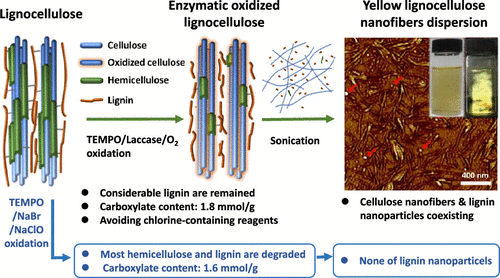当前位置:
X-MOL 学术
›
ACS Sustain. Chem. Eng.
›
论文详情
Our official English website, www.x-mol.net, welcomes your
feedback! (Note: you will need to create a separate account there.)
Influence of Chemical and Enzymatic TEMPO-Mediated Oxidation on Chemical Structure and Nanofibrillation of Lignocellulose
ACS Sustainable Chemistry & Engineering ( IF 7.1 ) Pub Date : 2020-08-25 , DOI: 10.1021/acssuschemeng.0c05291 Jie Jiang 1 , Huangjingyi Chen 1 , Liang Liu 1 , Juan Yu 1 , Yimin Fan 1 , Tsuguyuki Saito 2 , Akira Isogai 2
ACS Sustainable Chemistry & Engineering ( IF 7.1 ) Pub Date : 2020-08-25 , DOI: 10.1021/acssuschemeng.0c05291 Jie Jiang 1 , Huangjingyi Chen 1 , Liang Liu 1 , Juan Yu 1 , Yimin Fan 1 , Tsuguyuki Saito 2 , Akira Isogai 2
Affiliation

|
Chemically pretreated lignocellulose (CL) from poplar wood and commercial thermomechanical pulp (TMP) were oxidized using a TEMPO (2,2,6,6-tetramethylpiperidine-1-oxyl radical)/NaBr/NaClO system and a TEMPO/laccase/O2 system in water at pH 10 and 6.8, respectively. The formation rate of carboxylate groups was slower than that of delignification in the TEMPO/NaBr/NaClO oxidation of CLs. The carboxylate content of TEMPO/NaBr/NaClO-oxidized TMP rapidly achieved a stable value of 1.6 mmol/g along with continuous degradation of lignin. The yields and lignin contents of TEMPO/NaBr/NaClO-oxidized TMPs decreased from 95% to 70% and 17% to 5%, respectively. In contrast, the formation of carboxylate groups and delignification simultaneously occurred in TEMPO/laccase/O2 oxidation and resulted in less loss of lignin. The yields and lignin contents of oxidized TMPs containing 1.8 mmol/g carboxylate groups were 78% and 15%, respectively. The crystal structure of oxidized lignocellulose was minimally changed. The remaining lignin in TEMPO/NaBr/NaClO-oxidized TMP exhibited significant inhibition on the separation of nanofibers. However, TEMPO/laccase/O2-oxidized TMP exhibited high water retention values and good dispersion properties after sonication. When the TMP sample was oxidized 6 times via the TEMPO/laccase/O2 system and suffered sonication treatment, almost all lignin was well dispersed in water together with cellulose nanofibers. The obtained lignocellulose nanofibers exhibited the ability to prepare reduced Ag nanoparticles. The water contact angle of further prepared films was increased in comparison with that of pure cellulose nanofiber film.
中文翻译:

化学和酶的TEMPO介导的氧化对木质纤维素化学结构和纳米原纤化的影响
使用TEMPO(2,2,6,6-四甲基哌啶-1-氧基自由基)/ NaBr / NaClO系统和TEMPO /漆酶/ O 2氧化来自杨木的化学预处理木质纤维素(CL)和商用热机械浆(TMP)系统分别在pH值为10和6.8的水中。在CL的TEMPO / NaBr / NaClO氧化中,羧酸酯基的形成速率比去木质素的速率慢。TEMPO / NaBr / NaClO氧化的TMP的羧酸盐含量随着木质素的连续降解而迅速达到1.6 mmol / g的稳定值。TEMPO / NaBr / NaClO氧化的TMP的产率和木质素含量分别从95%降低到70%和17%降低到5%。相反,在TEMPO /漆酶/ O 2中同时发生羧酸酯基团和脱木素作用。氧化并减少了木质素的损失。含1.8 mmol / g羧酸根的TMP的得率和木质素含量分别为78%和15%。氧化木质纤维素的晶体结构变化很小。TEMPO / NaBr / NaClO氧化的TMP中剩余的木质素对纳米纤维的分离表现出显着的抑制作用。然而,TEMPO /漆酶/ O 2氧化的TMP在超声处理后显示出高保水值和良好的分散性能。当TMP样品通过TEMPO /漆酶/ O 2氧化6次时并经过超声处理,几乎所有木质素都与纤维素纳米纤维一起很好地分散在水中。所获得的木质纤维素纳米纤维表现出制备还原的Ag纳米颗粒的能力。与纯纤维素纳米纤维膜相比,进一步制备的膜的水接触角增加。
更新日期:2020-09-21
中文翻译:

化学和酶的TEMPO介导的氧化对木质纤维素化学结构和纳米原纤化的影响
使用TEMPO(2,2,6,6-四甲基哌啶-1-氧基自由基)/ NaBr / NaClO系统和TEMPO /漆酶/ O 2氧化来自杨木的化学预处理木质纤维素(CL)和商用热机械浆(TMP)系统分别在pH值为10和6.8的水中。在CL的TEMPO / NaBr / NaClO氧化中,羧酸酯基的形成速率比去木质素的速率慢。TEMPO / NaBr / NaClO氧化的TMP的羧酸盐含量随着木质素的连续降解而迅速达到1.6 mmol / g的稳定值。TEMPO / NaBr / NaClO氧化的TMP的产率和木质素含量分别从95%降低到70%和17%降低到5%。相反,在TEMPO /漆酶/ O 2中同时发生羧酸酯基团和脱木素作用。氧化并减少了木质素的损失。含1.8 mmol / g羧酸根的TMP的得率和木质素含量分别为78%和15%。氧化木质纤维素的晶体结构变化很小。TEMPO / NaBr / NaClO氧化的TMP中剩余的木质素对纳米纤维的分离表现出显着的抑制作用。然而,TEMPO /漆酶/ O 2氧化的TMP在超声处理后显示出高保水值和良好的分散性能。当TMP样品通过TEMPO /漆酶/ O 2氧化6次时并经过超声处理,几乎所有木质素都与纤维素纳米纤维一起很好地分散在水中。所获得的木质纤维素纳米纤维表现出制备还原的Ag纳米颗粒的能力。与纯纤维素纳米纤维膜相比,进一步制备的膜的水接触角增加。











































 京公网安备 11010802027423号
京公网安备 11010802027423号